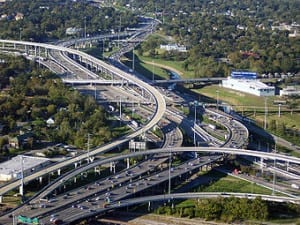
In the U.S. highways appeared around the same time that the highways in Germany, where they began to build by Adolf Hitler. Americans borrowed much from the German experience.
Roosevelt believed that the construction of highways crossing the country, will improve the situation in the U.S. economy. Construction of highways was launched in the midst of the “Great Depression”, an unprecedented economic crisis, and Roosevelt hoped that the road construction would reduce the unemployment rate.
At the beginning of XX century, cars were rare in the U.S. and a privilege of the rich.Ordinary Americans were content with horses or light crew, and, if need distance travel used trains. However, the situation changed after Henry Ford created the car assembly line. As a result, it became possible to make cars, affordable for the majority of the U.S. population. With the increasing number of vehicles on the road, it became clear that the U.S. mission in need of more advanced system of roads and highways. Top U.S. roads at that time were paved with cobblestones. Most back roads and even national highways had unpaved. In the early 1920s, the construction of roads in the United States has increased dramatically and there were more than 250 so-called “nominal highways”, named after historical figures and events, and had a color codification (on telegraph poles along the roads secured colored tape). The most famous of these highways was Lincoln Highway (Lincoln Highway), which crossed the whole of the United States, from New York to San Francisco.

In 1925, a law on federal assistance in the construction of roads, you used to create a new system of highways, subordinate states, not private companies. Stopped using the names and colors for road – each line was numbered code. Many states, along with a numbered code, however, chose to continue to give the names of the different pieces of the highway in the territory, as was common belief that the unnamed highway to bring bad luck. An example of this line can be a highway named after John F. Kennedy, now a part of the 60-mile highway I-95, stretching over more than two thousand miles, from Florida to Canada. This highway is located in the state of Maryland, and was named in honor of President Kennedy because he inaugurated the movement in this part of the track. As soon became clear, it was Kennedy’s last appearance at the official ceremony – a few days later he was killed.The first anniversary of the murder, in 1964, the highway was named Kennedy. For forty years the traffic on the highway Kennedy increased by 300% every year it passes 29 million vehicles.
In the late 1930s, the U.S. administration has developed a plan to create a first-federal system of highways. Legend has it that on the U.S. map, President Roosevelt drew three lines crossing the country far and three more – crossed across her and ordered the Bureau of Public Roads immediately begin construction of the highway.In 1938, the Law on federal highways, according to which the Bureau of Public Roads was indicated to explore the possibilities of creating toll roads. The idea was that all states have direct access to the road system. The Bureau recommended the build trunk road network, length of 27 thousand miles. But it was to be paid only in part, because there were fears that the economic crisis toll roads could cause mass discontent. It was assumed that the greater the length of the federal highways would have four lanes. More lanes to be built in areas where there was the possibility of more intensive traffic – more than 2 thousand vehicles per day (730 thousand per year).
In 1939, Roosevelt referred the report to the U.S. Congress, offering to take appropriate measures to establish inter-regional bus system. However, it soon began to prepare for the U.S. entry into World War II, and the construction of highways has faded into the background. In April 1941, Roosevelt established the National Committee for Interregional highways, to which was given the task of preparing a detailed plan. Committee proposed to build a network length of 36 thousand miles. In 1947, construction began. The project cost was estimated at $ 23 billion, which was to be funded from the budgets of the individual states.
Construction progressing very slowly due to lack of funds. Moreover, in 1950, the U.S. once again became involved in the war, this time in Korea. Construction of highways has also acquired military importance for the state. For this reason, in 1952, for the first time in history, the U.S. federal government has allocated $ 25 million of federal money to build this vast road network. The government has also established a system for the continuation of construction, will share the cost equally between the federal budget and the states. In 1953 more than 6 thousand miles of roads have been built at a cost of 955 million dollars
In 1953, U.S. President Dwight David Eisenhower was the (Eisenhower), who revealed himself as an ardent supporter of a national highway system. The reason for this was his military past. During World War II, Eisenhower praised the benefits that motorways gave German troops. The efforts of Eisenhower, in 1956 a law was passed which set the record straight “and”. Were finally approved route of the main highways, established a uniform design for highway and road signs. 12-year road construction budget was increased to $ 25 billion, of which 90% have pledged to pay the federal government. In 1990, in recognition of the Eisenhower, the then U.S. President George W. Bush signed the law, according to which a network of national highways has been renamed to System Highways named Eisenhower.
